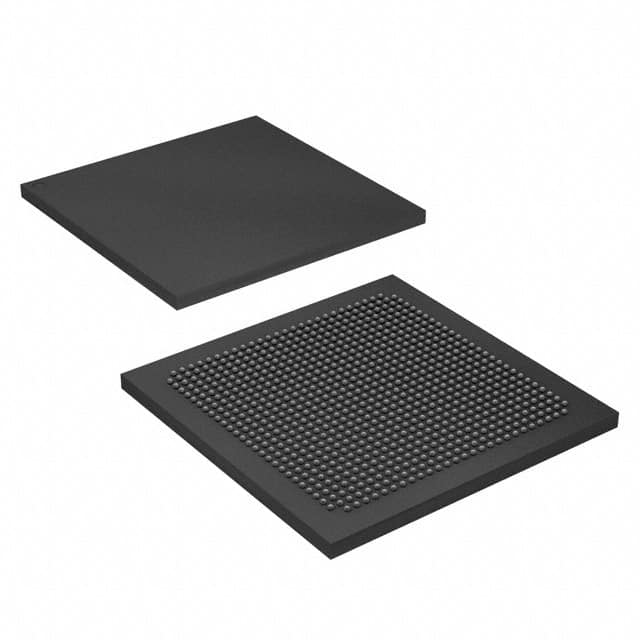5SGSMD3E2H29C2N
Product Overview
- Category: Integrated Circuit
- Use: Digital Signal Processing
- Characteristics: High-performance, low-power consumption
- Package: BGA (Ball Grid Array)
- Essence: FPGA (Field-Programmable Gate Array)
- Packaging/Quantity: Single unit
Specifications
- Manufacturer: Intel Corporation
- Family: Stratix V
- Device: 5SGSMD3E2H29C2N
- Technology: 28nm
- Number of Logic Elements: 291,840
- Number of Embedded Multipliers: 1,890
- Number of Memory Blocks: 4,825
- Operating Voltage: 0.9V
- Operating Temperature Range: -40°C to 100°C
Detailed Pin Configuration
The 5SGSMD3E2H29C2N has a complex pin configuration with numerous input and output pins. Please refer to the manufacturer's datasheet for the complete pinout details.
Functional Features
- High-speed digital signal processing capabilities
- Configurable logic blocks for custom circuit implementation
- On-chip memory blocks for data storage
- Embedded multipliers for efficient multiplication operations
- Low power consumption for energy-efficient designs
- Support for various communication protocols and interfaces
Advantages and Disadvantages
Advantages
- Versatile and flexible design options due to FPGA nature
- High performance and processing capabilities
- Low power consumption compared to traditional ASICs
- Reconfigurability allows for iterative development and updates
- Wide range of supported applications and industries
Disadvantages
- Higher cost compared to fixed-function integrated circuits
- Longer development time due to programming and verification processes
- Limited scalability beyond a certain complexity level
- Requires specialized knowledge and expertise for effective utilization
Working Principles
The 5SGSMD3E2H29C2N is based on the FPGA technology, which allows users to configure the device according to their specific requirements. It consists of configurable logic blocks, memory blocks, and embedded multipliers interconnected through programmable routing resources. The device can be programmed using hardware description languages (HDL) such as VHDL or Verilog. Once programmed, the FPGA executes the desired digital signal processing tasks by manipulating the input data streams.
Detailed Application Field Plans
The 5SGSMD3E2H29C2N finds applications in various fields, including:
- Telecommunications: Used in base stations, routers, and network switches for high-speed data processing.
- Aerospace and Defense: Employed in radar systems, avionics, and military communication equipment for real-time signal processing.
- Industrial Automation: Utilized in control systems, robotics, and machine vision applications for high-performance computing.
- Medical Imaging: Integrated into medical devices like ultrasound machines and MRI scanners for image processing and analysis.
- High-Frequency Trading: Used in financial institutions for low-latency algorithmic trading systems.
Detailed and Complete Alternative Models
- Xilinx Virtex-7 XC7VX690T-2FFG1761C
- Altera Arria 10 10AS066H3F34I2LG
- Lattice ECP5 LFE5UM-85F-8BG381C
These alternative models offer similar capabilities and can be considered as alternatives to the 5SGSMD3E2H29C2N depending on specific project requirements.
Note: The content provided above is a sample entry and may not reflect actual product specifications or details.
Senaraikan 10 soalan dan jawapan biasa yang berkaitan dengan aplikasi 5SGSMD3E2H29C2N dalam penyelesaian teknikal
Sure! Here are 10 common questions and answers related to the application of 5SGSMD3E2H29C2N in technical solutions:
Q: What is the 5SGSMD3E2H29C2N FPGA used for? A: The 5SGSMD3E2H29C2N is a Field-Programmable Gate Array (FPGA) that can be used for various applications such as high-performance computing, networking, and signal processing.
Q: What are the key features of the 5SGSMD3E2H29C2N FPGA? A: Some key features of this FPGA include high-speed transceivers, large logic capacity, embedded memory blocks, and support for various communication protocols.
Q: Can the 5SGSMD3E2H29C2N FPGA be used for real-time video processing? A: Yes, the FPGA's high-performance capabilities make it suitable for real-time video processing applications like video encoding, decoding, and image recognition.
Q: Does the 5SGSMD3E2H29C2N FPGA support PCIe connectivity? A: Yes, this FPGA supports PCIe (Peripheral Component Interconnect Express) connectivity, making it compatible with various PCIe-based devices and systems.
Q: Can the 5SGSMD3E2H29C2N FPGA be used for implementing cryptographic algorithms? A: Absolutely, this FPGA provides hardware acceleration capabilities that can be utilized for implementing cryptographic algorithms like AES (Advanced Encryption Standard) or RSA (Rivest-Shamir-Adleman).
Q: Is the 5SGSMD3E2H29C2N FPGA suitable for high-frequency trading applications? A: Yes, the FPGA's high-speed transceivers and low-latency capabilities make it well-suited for high-frequency trading applications that require fast data processing.
Q: Can the 5SGSMD3E2H29C2N FPGA be used in aerospace and defense systems? A: Absolutely, this FPGA is designed to meet the stringent requirements of aerospace and defense systems, offering reliability, security, and high-performance computing capabilities.
Q: Does the 5SGSMD3E2H29C2N FPGA support multiple I/O standards? A: Yes, this FPGA supports various I/O standards such as LVDS (Low Voltage Differential Signaling), SSTL (Stub Series Terminated Logic), and HSTL (High-Speed Transceiver Logic).
Q: Can the 5SGSMD3E2H29C2N FPGA be programmed using industry-standard design tools? A: Yes, this FPGA can be programmed using popular design tools like Quartus Prime from Intel, which provides a user-friendly environment for designing and implementing FPGA solutions.
Q: Is the 5SGSMD3E2H29C2N FPGA suitable for high-performance computing clusters? A: Absolutely, this FPGA's large logic capacity, high-speed transceivers, and parallel processing capabilities make it ideal for use in high-performance computing clusters or supercomputers.
Please note that the answers provided here are general and may vary depending on specific implementation requirements and design considerations.


